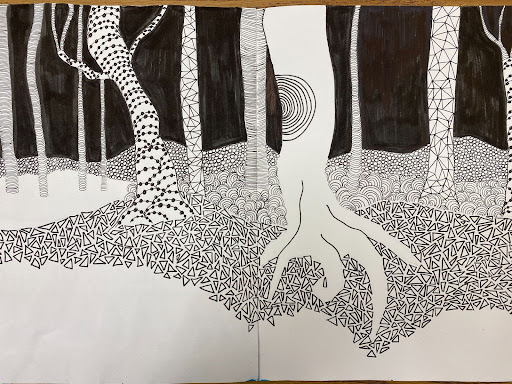Sketchbooks and Visual Journals in the Classroom

The Purpose of Sketchbooks
Visual records used in classrooms can encourage and develop student creativity, individual expression, and self-reflection. They can synthesize thinking and probe new ideas. Plus, visual notetaking not only improves memory, it engages learning. Not designed to be formal or finished works of art, (although they can be), sketchbooks and visual journals emphasize and document thinking processes. Instead of focusing on the perceived perfection of a final artwork or masterpiece, a sketchbook nurtures an appreciation for the process and journey of art-making and personal development.
Sketchbooks are not just for artists: anyone can benefit from using a sketchbook or visual journal. Maintaining a sketchbook or similar visual practice is useful for recording ideas and developing meaning-making skills that link memory with experience. Journals and sketchbooks cultivate curiosity, inquisitiveness, exploration, and imagination. They record progress and process.
Activity Ideas for a Sketchbook or Idea Book
SCRIBBLE (Doodle)
Make a line, then take it for a walk and see what happens. Put a mark on the paper and observe as the line transforms into something else.
KEEP AT IT
Draw, sketch, write, or scribble daily to promote creative thinking. Embrace the process.
EXPLORE and EXPRESS
Use a variety of media or drawing tools. Try a pen, graphite, or eraser as a drawing tool, colored pencils, ink, pastels, watercolors, or collage. Test new tools, vary the marks, and experiment with space, lines, shapes, colors, values, and scale. How can you vary your marks?
ADD TEXT TOO
Written text has its place in sketchbooks: date each exercise, and try to include a place as well. Express thoughts, add poems, words, feelings, ideas, or select one word to describe the daily entry. Using words with images adds depth to specific studies, fosters self-awareness, and generates new mental links and deeper understanding.
COLLECT
Staple or tape meaningful notes, receipts, ticket stubs, lists, or photos to sketchbook pages. Focus on items that spark a memory or experience. Adding these elements is a great way to integrate other curricular topics like math, reading, science, writing, history, and other art forms into the overall function of a sketchbook.
HAVE FUN
Invite personality and individuality to your sketchbook. Add color, text, drawings, patterns, or collage. Try using hole punches, stickers, pockets. Add transparent papers between pages. Be creative and inventive.
SKETCHING
The art of sketching is a fundamental skill. Sometimes it can be a doodle or just lines to express essentials. Quick, instinctive reactions with a drawing tool is a means of capturing a thought or idea. The sketching process involves observation, feeling, and interpretation. Brian Kershisnik, a famous local artist, constantly carries a little hand-made sketchbook of folded papers in his pocket. Any time he has to wait, he pulls it out and sketches. If he can’t think of something new to sketch, he sketches something he has sketched before in a new way. The sketching habit is something that could benefit all of us. The main thing is to start.
Do your students use sketchbooks? How has using sketchbooks changed your students’ learning experience? What is your favorite way to use a sketchbook? Share your ideas on social media and tag @everychildeveryart.

SKETCHBOOK EXAMPLES
Here are some sketchbook examples from art specialists, teachers, and others in our community. Some are doodles, notes, travel journals, ideas, drawings, explorations, creative ideas, thoughts. Can you identify different purposes for sketchbook pages?
From Mark Graham, BYU Art Education
From Tara Carpenter, BYU Art Ed
From James Rees, Provo School District
From Christine Brown, Art Education Supervisor
From Tamara Burnside, USBE
From Amanda Elton, BTS Art Specialist
From Heather Francis, BTS Arts, Dance
From Charlotte Hawkins, BTS Arts Specialist Alpine District
From Jackie Webster, BTS Arts Specialist
From Anna Davis, UAEA and Art Teacher, Timpanogos High
From Tina McCullogh
I change colors for key details around the main topic. A brace means a definition
Main ideas are found in boxes, clouds, or circles.
I use arrows, T charts, and Venn diagrams when I can.
These notes are just to help me attend to my readings. I like the big pages because most assignments/lectures fit on one page and that makes review
and locating needed info easy.
Often black pen or pencil is added to my reading notes during a lecture. It may be a comment from the professor, fellow student, or a new connection
or understanding I had.
Math and Science Sketchbook Samples from Valerie Louder’s Fourth-grade Class
Cindy Clark, BYU, and BTS Arts
Sometimes a sketchbook can have a theme. The sketchbook below is a prop for the ballet Sleeping Beauty.
Cindy Clark, BYU and BTS Arts, Covid Sketchbook
Page from Egypt Travel Journal, Cindy Clark
Page from Africa Travel journal, Cindy Clark






